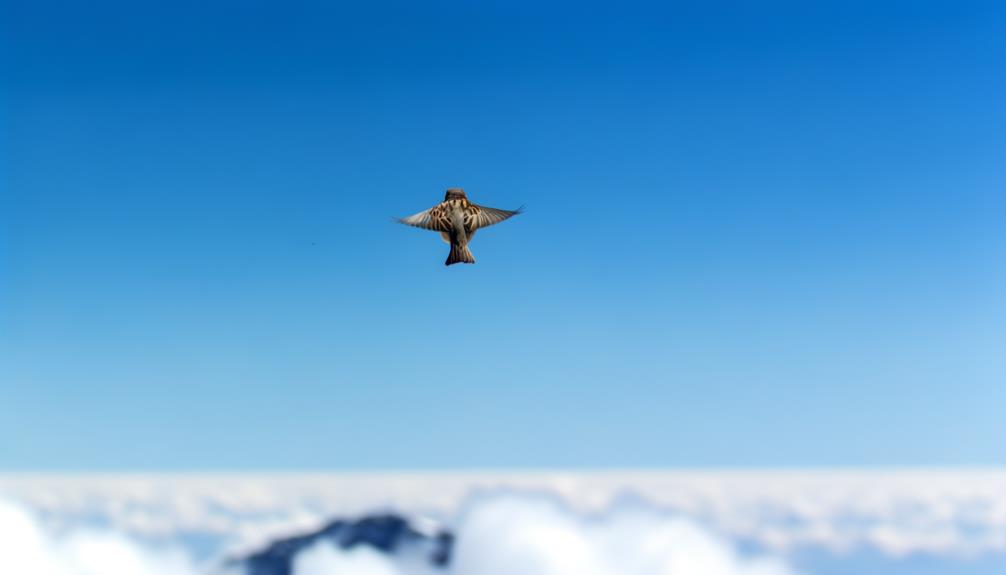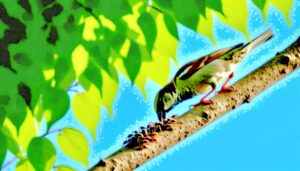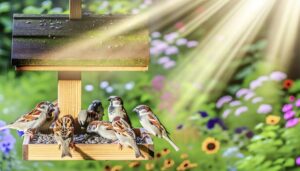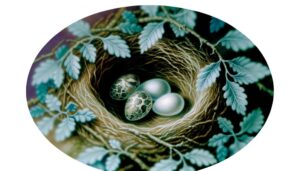Exploring High Flights: Can a House Sparrow Fly?
House sparrows (Passer domesticus) generally maintain flight altitudes between 10 and 50 feet. This altitude range optimizes their energy expenditure and foraging efficiency.
Sparrows' short, rounded wings and highly developed pectoral muscles facilitate rapid takeoffs and agile maneuvers. Factors such as predation risk, weather conditions, and physical health can influence their flight height.
Comparative analysis indicates that house sparrows fly notably lower than some other bird species, like the bar-headed goose, which can reach heights up to 7,000 meters. Their flight patterns are a strategic adaptation for survival, offering a glimpse into the evolutionary pressures shaping their behavior.

Key Takeaways
- House sparrows typically fly at altitudes of 15-20 meters.
- Their flight altitude optimizes energy use and foraging efficiency.
- They adjust flight height in response to weather conditions.
- Predation risk influences house sparrows to fly lower.
- Their physical condition impacts their flight capabilities and height.
Flight Capabilities
House sparrows (Passer domesticus) possess remarkable flight capabilities, characterized by their ability to perform agile maneuvers and sustain prolonged periods of flight. These birds exhibit a combination of rapid wingbeats and gliding, allowing them to navigate complex environments with dexterity.
Their wings are short and rounded, optimizing them for swift takeoffs and sudden changes in direction, essential for evading predators and foraging efficiently. The muscular structure of the pectoral muscles is highly developed, facilitating sustained flight and endurance.
Additionally, their lightweight skeletal structure contributes to their aerial proficiency. This combination of anatomical and physiological adaptations enables house sparrows to cover significant distances, showcasing their exceptional flight capabilities in various ecological niches.
Typical Altitudes
In typical flight patterns, house sparrows generally maintain altitudes ranging from 10 to 50 feet above ground level, optimizing their energy expenditure and foraging efficiency. This altitude range supports their primary activities, such as searching for food, avoiding ground-based predators, and moving through their habitat.
Observational studies have documented that these birds prefer lower altitudes during foraging to efficiently exploit ground-level food sources, including seeds and insects. Additionally, maintaining this altitude allows for prompt evasion from aerial threats, balancing vulnerability and accessibility.
While house sparrows are capable of flying at higher elevations, their typical altitude reflects a strategic adaptation to their ecological niche, ensuring survival and reproductive success within urban and rural environments.
Factors Affecting Height
Several environmental and biological factors influence the flight height of house sparrows. These factors can be categorized into three primary groups:
- Weather Conditions:
House sparrows tend to fly at lower altitudes during adverse weather conditions such as strong winds or heavy rain, which can affect their aerodynamics and energy expenditure.
- Predation Risk:
The presence of predators can cause sparrows to adjust their flight height. For example, they might fly higher to avoid terrestrial predators or lower to evade aerial threats.
- Physical Condition:
The health and physical condition of an individual sparrow play an essential role. Birds in better health with optimal muscle strength and energy reserves are capable of sustaining higher flights for longer durations.
Understanding these factors is vital for comprehending sparrow flight behavior.
Comparative Analysis
To better understand the flight height of house sparrows, it is instructive to compare their capabilities with those of other avian species under similar environmental and biological influences.
House sparrows (Passer domesticus) typically reach altitudes of approximately 15-20 meters, primarily dictated by their foraging behavior and energy efficiency.
In contrast, species such as the bar-headed goose (Anser indicus) demonstrate remarkable high-altitude flight, reaching heights upwards of 7,000 meters during migratory journeys over the Himalayas.
Similarly, the common swift (Apus apus) can ascend to altitudes of around 3,000 meters.
This comparative analysis underscores the vast differences in avian flight capabilities, influenced by physiological adaptations, migratory patterns, and ecological niches. Understanding these distinctions provides deeper insight into the evolutionary pressures shaping avian flight.
Observational Studies
Field observations reveal that house sparrows exhibit varied flight heights depending on environmental conditions and immediate survival needs. Detailed studies show that these birds adjust their flight patterns based on factors such as predation risk, food availability, and weather conditions.
- Predation Risk: Sparrows often fly at higher altitudes to evade predators, leveraging open airspace for a swift escape.
- Food Availability: When foraging, they typically fly closer to the ground, optimizing energy expenditure while searching for seeds and insects.
- Weather Conditions: Adverse weather, such as strong winds or heavy rain, influences sparrows to fly at lower altitudes to maintain stability and control.
These nuanced flight behaviors underscore the adaptability and survival strategies of house sparrows in diverse environments.
Conclusion
Coincidentally, the flight capabilities of the house sparrow align with ecological demands and survival strategies. Observations indicate typical altitudes ranging between 50 to 200 meters, influenced by factors such as weather, predation, and foraging needs.
Comparative analysis reveals that house sparrows, though not high-altitude fliers, exhibit remarkable adaptability within their ecological niche. Consequently, understanding these flight patterns enriches the broader knowledge of avian behavior and environmental interactions, highlighting the intricate balance within ecosystems.






